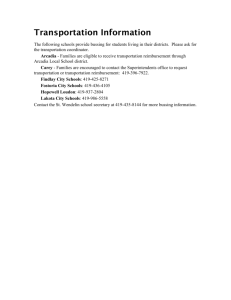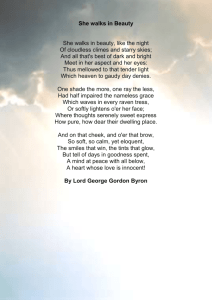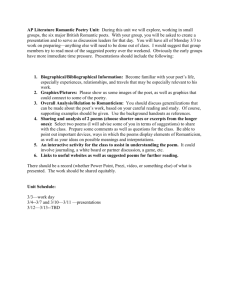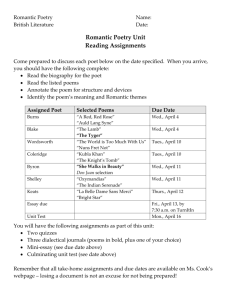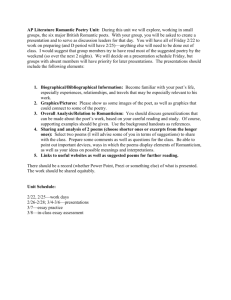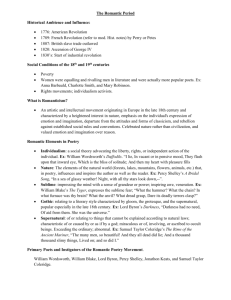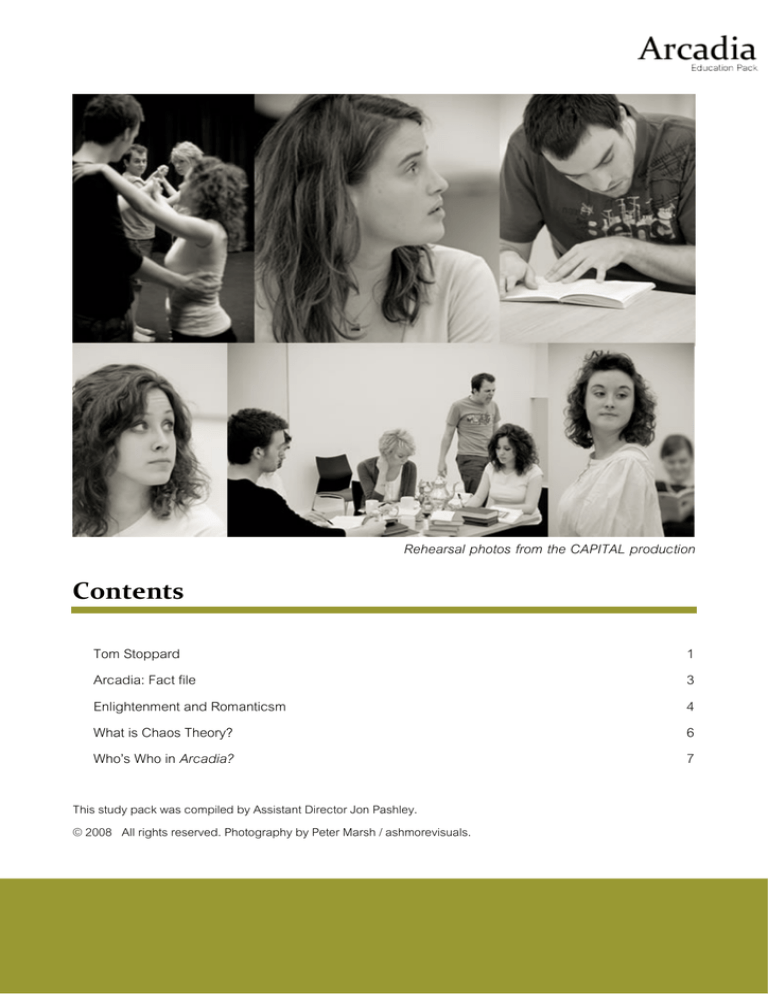
Rehearsal photos from the CAPITAL production
Contents
Tom Stoppard
Arcadia: Fact file
Enlightenment and Romanticsm
What is Chaos Theory?
Who’s Who in Arcadia?
This study pack was compiled by Assistant Director Jon Pashley.
© 2008 All rights reserved. Photography by Peter Marsh / ashmorevisuals.
1
3
4
6
7
Tom Stoppard
Tom Stoppard’s origins are in what is now the
Czech Republic and what was in 1937, the year of
Stoppard’s birth, Czechoslovakia. Stoppard’s family fled
the Nazis to Singapore (where Stoppard’s biological
father was killed), India, and finally arrived in Britain in
1946 complete with a new stepfather for Stoppard – a
British army officer. Amongst Stoppard’s earliest jobs
was journalism, and he has since written for the stage,
radio, television, and the screen. Famed for his oblique
manner, and ability to distance interviewers with
eminently quotable, but slightly puzzling remarks,
Stoppard’s persona is enigmatic – somewhere between
a 18th century boulevardier and a rock star. Emerging
partly from the great traditions of Eastern European
drama, and partly from a firmly Western mode,
Stoppard’s work has tended to evade easy classification.
True, certain strong themes are evident and these tend to
figure in small batches of plays: Jumpers (1972) and
Travesties (1974), for example, are flavoured with
absurdism. The suppression of human rights in the
Eastern bloc heavily influenced material like Every Good
Boy Deserves Favour, and Professional Foul (1977) –
themes that recurred in Dogg's Hamlet, Cahoot's
Macbeth (1979), and Squaring the Circle (1984).
Intellectual history is never far from the surface either:
Arcadia, and The Coast of Utopia (2002), for example.
Stoppard is capable, also, of domesticating politics: his
1
study of the poet Housman’s lengthy and
unconsummated love for a young male athlete in The
Invention of Love (1997) was extremely well received by
critics. It should not be overlooked, either, that
Stoppard’s plays are frequently funny, manifesting an
overt intellectualism constantly undercut by a refined
facetiousness. Above all, though, his works are about the
business of ideas, and the performance of those ideas.
Like few other playwrights Stoppard is able to make his
work performative in the sense that he attempts to
incorporate the governing ideas into the very fabric and
structure of a piece. This is what sets him apart, I believe,
as one of our most fascinating living dramatists.
Dr Nicholas Monk
Research Fellow at the CAPITAL Centre
Research interests include the relationship between pedagogy
and performance, theories of modernity, and the "postsecular"
in society. He has published on Cormac McCarthy and Native
American Literature.
Further reading:
Jim Hunter, ‘Rosencrantz and Guildenstern are Dead’, ‘Jumpers’, ‘Travesties’, ‘Arcadia’
(Faber Critical Guides)
Katherine E. Kelly, The Cambridge Companion to Tom Stoppard
http://www.contemporarywriters.com/authors/?p=auth254 (British Council Arts Group website)
http://www.sondheimguide.com/Stoppard/
2
Arcadia: Fact file
First performance
Arcadia opened at the Lyttelton Theatre, Royal National Theatre, on 13 April 1993. The production was
directed by Trevor Nunn.
Title
Arcadia is a real area of rural Greece. In arts and literature, it has come to signify an ideal, pastoral
setting. The phrase Et in Arcadia ego comes from a seventeenth-century painting by Nicolas Poussin called
Les Bergers d’Arcadie (The Arcadian Shepherds) which features a group of shepherds grouped around a
tomb on which the phrase is written. Translation of this phrase is subject to controversy as it contains no verb,
literally it renders ‘And in Arcadia I’. William Hazlitt suggested, in the nineteenth century, ‘I was also an
Arcadian’, in reference to the deceased; other suggestions include ‘Even in Arcadia, there am I/I exist’, where
the speaker is a personified Death: the suggestion is that death pervades even the most idyllic world and that
all good things must inevitably come to an end. This idea permeates the play in many ways, the most literal
example being the hunting which takes place in the halcyon settings of Sidley Park. Erwin Panofsky wrote a
famous essay on the painting, published in his Meaning in the Visual Arts, in which he discusses
interpretations of the memento mori.
Structure
The play is written in two acts, with four scenes in the first and three in the second. The scenes alternate
between two periods, the nineteenth century and the “present day”, with the exception of the last scene of the
first act and the first of the second, which are both set in the present. This is the only instance of consecutive
scenes taking place in the same period. In the final scene, the action of the two periods overlaps and
interweaves. All the action takes place in a single room in a large, country house in Derbyshire.
In 1809, thirteen-year-old Thomasina Coverly, under the tutelage of Septimus Hodge, questions the
“natural order” of things and starts thinking about the world in a way which anticipates the laws of
thermodynamics and chaos theory, but what she is really interested in is sex. Meanwhile, in the present day,
garden historian Hannah Jarvis and Byron scholar Bernard Nightingale are making their own discoveries. By
interlacing these stories, Stoppard examines the ways in which we enter into a dialogue with what came
before us and how we try to make sense of the world as scientists, poets, mathematicians, landscape
designers, physicists and lovers.
3
Enlightenment and Romanticism
Arcadia is set on the cusp of things, on the edge of
nineteenth-century Romanticism as it develops out of
eighteenth-century Enlightenment. The situation, as
Hannah at first sees it, looking back from the present day,
is one the degeneration and decadence of rational
thought:
A century of intellectual rigour turned in on itself. A mind in
chaos suspected of genius. In a setting of cheap thrills
and false emotion.
What Arcadia is also set on the edge of is Byronism, with
its emphasis on personality and posturing, on creating
one’s self for the look of others. Arcadia opens in 1809,
three years before Byron awoke and found himself
famous with the publication of his travel poem Childe
Harold. But Arcadia is also too smart a play to believe in
simple transitions from one thing to another.
Reason may be dissolving in a period that
emphasizes the observer’s paradox, the way that who is
looking changes what is seen, but that also means one
thing never simply changes into something absolutely
uniquely different. Byron is not just a Romantic author. He
is also, at least to Bernard, ‘an eighteenth-century
Rationalist touched by genius’, although given Bernard’s
own personality, one never knows whether we can trust any
of his judgments in the play (not least when he is so wrong
about Byron’s role in the events at Sidley Park). How things
come out of each other, the nature of causation, and
4
Lord Byron
whether there is free will or determinism, are major
questions for the Enlightenment that the play shows
undergoing the Romantic turn which ultimately produces
the chaos theory in our own times. Everything is related to
everything else, but for the post-romantic imagination it’s
related in ways so complex that it is almost impossible to
compute. For Bernard, this means the attempt at
knowledge might as well be sacrificed to the cult of
‘personality’. But for Byron himself, and contemporaries like
Hazlitt and Keats, it was more a case of
I had a dream, which was not all a dream,
the way everything has to be computed The bright sun was extinguish’d, and the stars
Did wander darkling in the eternal space,
through what Hazlitt called ‘our mixed Rayless, and pathless; and the icy earth
Swung blind and blackening in the moonless air…
imperfect being.’
from ‘Darkness’, Lord Byron
Far from a Romantic belief in
the primacy of the self, the stability of identity itself seems
uncertain, we see a world in which everything is connected
to everything else, including the present to the past, in
ways so complex they are almost impossible to disentangle.
We might think of this complex web as a form of Romantic
skepticism, except that it is a phenomenon stretching from
David Hume’s critique of the Enlightenment from within and
his enquiries into the uncertainties of cause and effect and
the dependence of reason upon the passions. What the
play leaves us with, though, is something like Byron’s own
axiom: ‘I deny nothing, but doubt everything’.
Jon Mee
Professor of Romanticism Studies, University of Warwick
Writings include Romanticism, Enthusiasm, and Regulation:
Poetics and the Policing of Culture in the Romantic Period and
Dangerous Enthusiasm: William Blake and the Culture of
Radicalism in the 1790s.
5
What is Chaos Theory?
Chaos is irregular and unpredictable
behaviour occurring in a system that runs
according to rigid rules that have no explicit
random features. This combination may seem
paradoxical, but it is actually very common.
For instance, there is chaos in your
kitchen.
When you make bread you knead the
dough, repeatedly stretching it and folding it
back together. This process mixes up the
ingredients, because stretching the dough
smears out any lumps where, say, there is a lot
of flour. The subsequent folding stops the
dough escaping from the kitchen, and makes it
possible to repeat the operation over and over
again.
The mixing process does not rely on
any random effects. Simple mathematical
models show that a perfectly regular stretchand-fold procedure still mixes everything up,
Even when the future movements of every
single particle of flour are completely
determined by the kneading procedure, the
fate of any particular particle is unpredictable,
because we can never be completely sure
where any particle of flour is right now. When
we knead the dough, any two nearby particles
quickly move apart, each doing its own thing.
Any error in our measurement of the position of
such a particle, however small, in effect
replaces it by a different, nearby particle.
However close this ‘ghost particle’ may be to
the real one, the mixing process gives it a very
different future. So in practice we have no idea
of precisely how the particle will move as time
passes.
The kneading process is a dynamical
system—something whose immediate future is
determined by its present according to some
fixed rule. The long-term future can be found,
in principle, by applying the rule over and over
again. Such systems are inherently
deterministic: if we know exactly where to start,
there is only one possible future. In practice,
however, we don’t know exactly where to start.
We can’t measure the present state with infinite
precision. Repetitions of the rule magnify the
6
tiniest error until it swamps any prediction. This
is the famous “butterfly effect”, in which a flap
of a butterfly’s wing causes a long-term change
in the weather. It was noticed in 1963 by the
meteorologist Edward Lorenz (who died in April
2008). Any dynamical system in which tiny
errors grow rapidly is said to be “chaotic”.
Weather is a good example, in fact. Of
course in the real world we can’t run the
weather twice, changing only one flap of one
wing. But the butterfly effect is commonplace in
the mathematical models used to forecast
weather, and it is why forecasts three or four
days ahead are usually wrong. And those
methods are based on very accurate physical
representations of how real weather behaves.
“Chaos theory” is a name given by the
media to the study of chaotic dynamics.
Mathematicians prefer to think of it as just one
new component of an old subject, dynamical
systems. But it is a very significant component,
because it changes our view of what a
deterministic system can do, and what we
mean by a scientific prediction. Chaos became
widely known in the 1960s, after a lengthy
“prehistory”. It is now a routine part of the
scientific and mathematical toolkit, and it
shows up in virtually all branches of science.
Its applications include hard-core physics such
as the behaviour of variable stars, biological
questions such as the dynamics of animal
populations or the spread of epidemics, and
how the blood vessels in the human body
transport oxygen. It has even been used to
measure the quality of wire used in making
springs.
Ian Stewart
Professor of Mathematics, University of Warwick
Writings include What Shape is a Snowflake?
(2001), How to Cut a Cake (2006) and Why
Beauty is Truth (2007).
Further reading:
James Gleik, Chaos: The Amazing
Science of the Unpredictable
Who’s Who in Arcadia?
Aeschylus
A survival guide to name-dropping in the play
(525-456 BCE) Believed to be the first Greek tragedy-writer (the first to write for two
characters), though many of his plays are believed to have been lost, he is still
celebrated for his Oresteia trilogy and Prometheus Bound.
Archimedes (c. 287-c. 212 BCE) Ancient Greek mathematician, physicist, engineer and inventor. He
calculated the value of pi and invented, amongst other things, the Archimedes’ screw.
Aristotle
(384-322 BCE) Ancient Greek philosopher whose writings on poetics, metaphysics
ethics, logic, politics have been hugely influential in western European thought.
Brown
Launcelot “Capability”, (1715-1783), English landscape architect who designed the
gardens at Kew and Blenheim Palace.
Brummell
George Bryan “Beau”, (1778-1840), English “dandy” who began the fashion for men to
wear understated, tailored clothes with cravats. A friend of King George IV, he is
thought to be the originator of the modern suit worn with a tie.
Claude
Claude Lorrain, (1600-1682), French landscape painter.
Cleopatra
(69-30 BCE) Queen of Egypt, daughter of Ptolemy XII with whom she initially shared
power. Latterly, she co-ruled with her husband-brothers Ptolemy XIII and Ptolemy XIV.
She joined forces with Julius Caesar to overthrow her brother and gain sole sovereignty,
later becoming Caesar’s mistress. After the emperor’s murder, she married Marc
Antony whom she later married. They were defeated by Octavian in 31 BCE and both
committed suicide.
Byron
George Gordon Sixth Baron Byron of Rochdale, (1788-1824), Romantic poet who was
one of the leading figures of the Romantic Movement. He was notorious for his
unconventional lifestyle and his numerous sexual liaisons; his mistress was Lady
CAROLINE LAMB. He died in mainland Europe, having fought Greek independence from
the Turkey. His works include Manfred, Childe Harold and Don Juan.
Chippendale Thomas, (1718-1779), English cabinet-maker whose style is recognized by flowing lines
a rococo ornamentation.
Coleridge
Samuel Taylor, (1772-1834), English poet and a leader of the Romantic Movement, a
writer of notable criticism on Shakespeare. He is probably most famous for his poem
The Rime of the Ancient Mariner.
Dido
(sometimes known as Elissia) Dido is the fabled queen of Carthage. In Virgil’s Aeneid,
she falls in love Aeneas but, when Aeneas is instructed by the gods to journey away,
she kills herself.
Elizabeth
Queen Elizabeth I, (1533-1603), Protestant queen of England who re-established the
faith when she succeeded the Catholic Mary I. Daughter of Henry VIII, she famously
remained a virgin. Her reign coincided with the Renaissance, a rediscover of classical
culture and a time of massive developments in science, trade and culture.
Euripides
(c. 480-406 BCE) Ancient Greek playwright, his work is thought to be more realistic than
that of AESCHYLUS and SOPHOCLES: Iphigenia in Taurus, The Bacchae, Medea,
Hippolytus and The Trojan Women.
Fermat
Pierrre de, (1601-1665), a French mathematician credited with the early development
of calculus and magistrate at the Parlement at Toulouse, France.
Fuseli
Henry, (1741-1825), Swiss-born British painter famous his grotesque and fantastic style,
probably his most famous painting, The Nightmare, depicts a satanic creature upon a
sleeping woman.
Galileo
(1564-1642), Italian astronomer, physicist and mathematician. Best known for being the
first scientist to observe the sky through a telescope and for his support for Copernicus’
theory that the Earth revolved around the Sun.
Lamb
Lady Caroline, (1785-1828), writer of Glenarron, Graham Hamilton and Ada Reis, wife
of Viscount Melbourne and BYRON’s mistress.
Lawrence
D. H., (1885-1930), English writer of fiction and criticism, possibly most famous for his
novels which include Sons and Lovers, Women in Love and Lady Chatterley’s Lover.
Leibnitz
Gottfried Willhelm, (1646-1716), German philosopher and mathematician who invented
calculus independently from Newton, his notation is used to date.
Lord Holland Henry Richard Vassall Fox, 3rd Baron (1773-1840) was an English politician, an
important member of the Whig party, and a writer. A statue of him stands in Holland
Park, London.
8
Jeffrey
Milton
Moore
Newton
Ovid
Peacock
Pericles
Plautus
Radcliffe
Rogers
Rosa
Scott
Francis, or Lord Jeffrey, (1773-1850), Scottish critic renowned for his dislike for
Romantic poetry. He was co-founder and editor of the Edinburgh Review, which
provided BYRON with ammunition for his English Bards and Scotch Reviewers.
John, (1608-1674), English poet most famous for writing Paradise Lost, which narrates
Satan’s Fall from Grace and the expulsion of Adam and Eve from the Garden of Eden. It
is considered by some to be the greatest English epic.
Thomas, (1779-1852), Irish poet and biographer of Lord Byron.
Sir Isaac, (1642-1727), English mathematician and scientist who invented differential
calculus. He also originated the theories of universal gravitation and the three laws of
motion, the foundation of modern engineering. His theories asserted that the solar
system does in fact orbit the sun.
(43 BCE-17 CE) Roman poet, trained as a lawyer, known for his erotic and mythological
poems including Ars Amores (The Art of Love) and Metamorphoses.
Thomas Love, (1785-1866), English novelist and poet, friend to Shelly and a clerk of the
East India Company.
(c. 495 – 429 BCE) Ancient Athenian statesman: a fierce promoter of democracy,
leading Thucydides to give him the epithet of ‘the first citizen of Athens’, and a staunch
patron of the arts, which flourished during his time in power. Achievements of this
Golden Age include Pericles’ commission of the Parthenon.
(c. 254-184 BCE) Roman poet and playwright famed for coarse comedies.
Ann Ward, (1764-1823), English novelist considered a pioneer in the gothic style. Her
works include The Mysteries of Udolpho, to which Henry James makes reference in his
The Turn of the Screw.
Samuel, (1763-1855), British poet: The Pleasures of Memory.
Salvator, (1615-1673), Italian painter and poet known for his romantic depictions of wild
landscapes as well as turbulent seascapes and battle scenes.
Sir Walter, (1771-1832), Scottish poet and novelist, the writer of Ivanhoe (1820) which is
sometime credited for a renewal of interest in the Middle Ages during the nineteenth
century.
9
Sophocles
(496-406 BCE) Greek tragedian whom ARISTOTLE credits with the addition of a third actor
as well as increasing the size of the chorus, believed to have been responsible for the
development of stage settings. His tragedies include Oedipus Rex, Electra, The
Women of Trachis, Antigone and Oedipus at Colonus.
Southey
Robert, (1774-1843), English Romantic poet and scholar. In 1813 he was appointed
Poet Laureate after Sir WALTER SCOTT declined the offer. Southey is the dedicatee of
BYRON’s Don Juan, in which dedication he is insulted for his poetry and his politics.
Thackeray William Makepeace, (1811-1863), English novelist, the author of Vanity Fair.
Virgil
(70-19 BCE), Roman poet, writer of the epic Aeneid which recounts the journeys of
Aeneas, starting with the fall of Troy and ending with the founding of Rome. Also the
writer of The Georgics which established the classical pastoral tradition.
Walpole
Horace, 4th Earl of Orford, (1717-97), writer of the Gothic romance The Castle of Oranto.
His Gothicized villa, Strawberry Hill, London, is credited with starting the picturesque
fashion in landscape design; it featured in the BBC’s Restoration series in 2004.
Wordsworth William, (1770-1852), English poet, a founder of the Romantic movement. He co-wrote
Lyrical Ballads with COLERIDGE and was made Poet Laureate in 1843.
10

